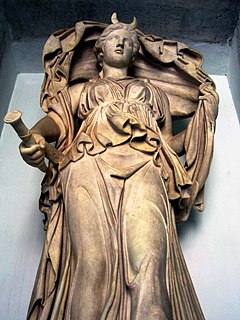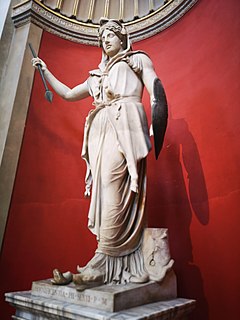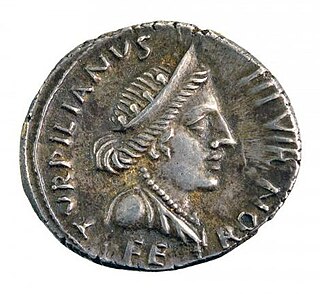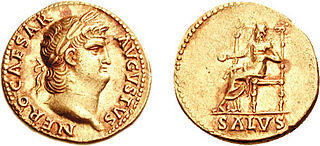Related Research Articles

Venus is a Roman goddess, whose functions encompassed love, beauty, desire, sex, fertility, prosperity and victory. In Roman mythology, she was the ancestor of the Roman people through her son, Aeneas, who survived the fall of Troy and fled to Italy. Julius Caesar claimed her as his ancestor. Venus was central to many religious festivals, and was revered in Roman religion under numerous cult titles.

In ancient Roman religion and myth, Luna is the divine embodiment of the Moon. She is often presented as the female complement of the Sun, Sol, conceived of as a god. Luna is also sometimes represented as an aspect of the Roman triple goddess, along with Proserpina and Hecate. Luna is not always a distinct goddess, but sometimes rather an epithet that specializes a goddess, since both Diana and Juno are identified as moon goddesses.

In Roman religion, Angerona or Angeronia was an old Roman goddess, whose name and functions are variously explained. She is sometimes identified with the goddess Feronia.

Furrina, also spelled Furina, was an ancient Roman goddess whose function had become obscure by the 1st century BC. Her cult dated to the earliest period of Roman religious history, since she was one of the fifteen deities who had their own flamen, the Furrinalis, one of the flamines minores. There is some evidence that Furrina was associated with water.
Libitina, also Libentina or Lubentina, is an ancient Roman goddess of funerals and burial. Her name was used as a metonymy for death, and undertakers were known as libitinarii. Libitina was associated with Venus, and the name appears in some authors as an epithet of Venus.

In ancient Roman religion, Strenua or Strenia was a goddess of the new year, purification, and wellbeing. She had a shrine (sacellum) and grove (lucus) at the top of the Via Sacra. Varro said she was a Sabine goddess. W.H. Roscher includes her among the indigitamenta, the lists of Roman deities maintained by priests to assure that the correct divinity was invoked in public rituals. The procession of the Argei began at her shrine.

Neptune is the god of freshwater and the sea in Roman religion. He is the counterpart of the Greek god Poseidon. In the Greek-influenced tradition, Neptune is the brother of Jupiter and Pluto; the brothers preside over the realms of Heaven, the earthly world, and the Underworld. Salacia is his wife.
The Robigalia was a festival in ancient Roman religion held April 25, named for the god Robigus. Its main ritual was a dog sacrifice to protect grain fields from disease. Games (ludi) in the form of "major and minor" races were held. The Robigalia was one of several agricultural festivals in April to celebrate and vitalize the growing season, but the darker sacrificial elements of these occasions are also fraught with anxiety about crop failure and the dependence on divine favor to avert it.

Juno is an ancient Roman goddess, the protector and special counsellor of the state. A daughter of Saturn, she is the wife of Jupiter and the mother of Mars, Vulcan, Bellona and Juventas. She is the Roman equivalent of Hera, queen of the gods in Greek mythology; like Hera, her sacred animal was the peacock. Her Etruscan counterpart was Uni, and she was said to also watch over the women of Rome. As the patron goddess of Rome and the Roman Empire, Juno was called Regina ("Queen") and was a member of the Capitoline Triad, centered on the Capitoline Hill in Rome; it consisted of her, Jupiter, and Minerva, goddess of wisdom.

Fauna[ˈfau̯na] is a Roman rustic goddess said in differing ancient sources to be the wife, sister, or daughter of Faunus. Varro regarded her as the female counterpart of Faunus, and said that the fauni all had prophetic powers. She is also called Fatua or Fenta Fauna.

In ancient Roman religion, Feronia was a goddess associated with wildlife, fertility, health, and abundance. As the goddess who granted freedom to slaves or civil rights to the most humble part of society, she was especially honored among plebeians and freedmen. Her festival, the Feroniae, was November 13 during the Ludi Plebeii, in conjunction with Fortuna Primigenia; both were goddesses of Praeneste.
In ancient Roman religion, the Lucaria was a festival of the grove held July 19 and 21. The original meaning of the ritual was obscure by the time of Varro, who omits it in his list of festivals. The deity for whom it was celebrated is unknown; if a ritual for grove-clearing recorded by Cato pertains to this festival, the invocation was deliberately anonymous (Si deus, si dea). The dates of the Lucaria are recorded in the Fasti Amiterni, a calendar dating from the reign of Tiberius found at Amiternum in Sabine territory.
An Agonalia or Agonia was an obscure archaic religious observance celebrated in ancient Rome several times a year, in honor of various divinities. Its institution, like that of other religious rites and ceremonies, was attributed to Numa Pompilius, the semi-legendary second king of Rome. Ancient calendars indicate that it was celebrated regularly on January 9, May 21, and December 11.

Feronia or Lucus Feroniae was an ancient town of southern Etruria, at the foot of Mount Soracte, within the territory of Capena, with a temple or shrine of the goddess from whom it derived its name, and a sacred grove, attached to it. Strabo, indeed, is the only author who mentions a town of the name, which he calls Feronia; other writers speak of Lucus Feroniae and Feroniae fanum, but it is natural that in process of time a town should have grown up around a site of so much sanctity, and which was annually visited by a great concourse of persons. Feronia appears to have been a Sabine goddess, and hence the festivals at her shrine seem to have been attended especially by the Sabines, though the sanctuary itself was in the Etruscan territory, and dependent upon the neighbouring city of Capena The first mention of these annual festivals occurs as early as the reign of Tullus Hostilius, when we find them already frequented by great numbers of people, not only for religious objects, but as a kind of fair for the purposes of trade, a custom which seems to have prevailed at all similar meetings. Great wealth had, in the course of ages, been accumulated at the shrine of Feronia, and this tempted Hannibal to make a digression from his march during his retreat from Rome, in 211 BCE, for the purpose of plundering the temple. On this occasion he despoiled it of all its gold and silver, amounting to a large sum, besides which there was a large quantity of rude or uncoined brass, a sufficient proof of the antiquity of the sanctuary. The only other notices of the spot which occur in history are some casual mentions of prodigies that occurred there; but Strabo tells that it was still much frequented in his time, and that many persons came thither to see the miracle of the priests and votaries of the goddess passing unharmed through a fire and over burning cinders. This superstition is ascribed by other writers to the temple of Apollo, on the summit of Mount Soracte. It was probably transferred from thence to the more celebrated sanctuary at its foot.

Vulcan is the god of fire including the fire of volcanoes, deserts, metalworking and the forge in ancient Roman religion and myth. He is often depicted with a blacksmith's hammer. The Vulcanalia was the annual festival held August 23 in his honor. His Greek counterpart is Hephaestus, the god of fire and smithery. In Etruscan religion, he is identified with Sethlans.

The Vinalia were Roman festivals of the wine harvest, wine vintage and gardens, held in honour of Jupiter and Venus. The Vinalia prima, also known as the Vinalia urbana was held on 23 April to bless and sample last year's wine and ask for good weather until the next harvest. The Vinalia rustica was on 19 August, before the harvest and grape-pressing.

In ancient Roman religion and myth, the Querquetulanae or Querquetulanae virae were nymphs of the oak grove (querquetum) at a stage of producing green growth. Their sacred grove (lucus) was within the Porta Querquetulana, a gate in the Servian Wall. According to Festus, it was believed that in Rome there was once an oakwood within the Porta Querquetulana onto the greening of which presided the virae Querquetulanae.

In ancient Roman religion, a sacellum is a small shrine. The word is a diminutive from sacer. The numerous sacella of ancient Rome included both shrines maintained on private properties by families, and public shrines. A sacellum might be square or round.

Salus was a Roman goddess. She was the goddess of safety and well-being of both the individual and the state. She is sometimes equated with the Greek goddess Hygieia, though her functions differ considerably.
References
- ↑ Varro, De lingua latina 5.84.
- ↑ Nunc vix nomen notum paucis: Varro, De lingua latina 6.19.
- ↑ Varro, De lingua latina 6.19: cuius deae honos apud antiquos, nam ei sacra instituta annua et flamen attributus.
- ↑ Ken Dowden, European Paganism: The Realities of Cult from Antiquity to the Middle Ages (Routledge, 2000), p. 239.
- ↑ Robert Schilling, "Neptune," Roman and European Mythologies (University of Chicago Press, 1992, from the French edition of 1981), p. 138. This was the earlier view of Georg Wissowa.